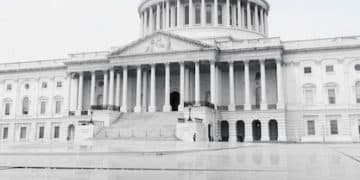Military Spending and US Political Priorities in 2025: A Forecast

Increased military spending in 2025 is poised to significantly reshape domestic political priorities in the US, potentially diverting resources from areas like healthcare, education, and infrastructure, while also intensifying debates over national security versus social welfare.
What impact will the escalating military budget have on the political landscape of the US in 2025? Examining the potential shifts in domestic priorities due to increased defense expenditures, we’ll uncover the delicate balance between national security and vital social programs. Find out how will the increased military spending affect domestic political priorities in 2025?
Understanding the Context of Increased Military Spending
The global landscape is constantly evolving, and with that comes shifts in national priorities. An increase in military spending often signals a perceived rise in threats or a change in geopolitical strategy. Let’s delve into the factors driving this potential surge and its immediate implications.
Geopolitical Instability: A Catalyst for Increased Spending
Rising geopolitical tensions, such as conflicts in various regions, often lead to increased military spending as nations seek to bolster their defense capabilities. These tensions can range from regional disputes to larger-scale international conflicts.
Modernization of Military Technology
The rapid advancement of military technology necessitates continuous investment in research, development, and procurement of new weaponry and systems. This modernization drive can significantly contribute to increased military budgets.
The consequences of such spending could be extensive. Here are some possible ramifications:
- Increased national debt due to higher budget allocations.
- Potential trade-offs in funding for social programs and infrastructure.
- Shifts in political discourse, with debates focusing on security versus domestic needs.
- Realignment of international relations as nations respond to changing military capabilities.
In conclusion, the decision to increase military spending is heavily influenced by global events and technological advancements. Understanding this context is crucial for evaluating the potential impact on domestic political priorities.

Potential Impact on Healthcare Funding
One of the most debated areas when military spending increases is the potential impact on healthcare. With a larger portion of the budget allocated to defense, other sectors like healthcare often face cuts or limited growth. This section explores the potential scenarios and the political fallout.
Reduced Investment in Public Health Programs
An increase in military spending might lead to reduced funding for public health initiatives, such as disease prevention, health education, and community health centers. This could disproportionately affect vulnerable populations.
Strained Healthcare Infrastructure
Hospitals, clinics, and other healthcare facilities may struggle to maintain adequate staffing and resources if government funding is reduced, leading to longer wait times and compromised care quality.
The political landscape could see intensified debates. Consider these possible outcomes:
- Increased advocacy for universal healthcare as a means of ensuring access regardless of budget allocations.
- Partisan battles over the allocation of resources, with differing views on the importance of military versus social spending.
- Public outcry if healthcare services are visibly affected by budget cuts.
- Calls for greater efficiency and accountability in healthcare spending to maximize the impact of available funds.
In summation, the healthcare sector is closely tied to budgetary decisions, and an increase in military spending could put a significant strain on its resources. The political response will likely be contentious, with advocates on both sides vying for their priorities.
The Fate of Education Initiatives
Education is often seen as a cornerstone of societal progress, but it too can be vulnerable when budgets are re-prioritized. Increased military spending could lead to cuts in educational funding, impacting schools, universities, and various educational programs. Let’s investigate the potential consequences.
Decreased Funding for Schools and Universities
Public schools and universities might face budget cuts, resulting in larger class sizes, reduced resources, and potential layoffs of teachers and staff. This can negatively affect the quality of education.
Reduced Access to Higher Education
Financial aid programs, scholarships, and grants for students may be reduced, making it more difficult for individuals, especially those from low-income backgrounds, to afford higher education.
How might this play out politically? Several scenarios are possible:
- Heightened debates over the value of education versus military strength, with arguments for investing in human capital versus defense capabilities.
- Grassroots movements advocating for increased educational funding and protesting against budget cuts.
- Political platforms that prioritize education as a means of boosting long-term economic growth and social mobility.
- Calls for innovative solutions to improve educational outcomes despite limited resources, such as increased use of technology and community partnerships.
To conclude, education initiatives often find themselves competing for resources with military spending. The resulting political dynamics can significantly influence the future trajectory of educational opportunities and outcomes.
Infrastructure Development: A Balancing Act
Infrastructure, the backbone of a functioning society, is another area that could be affected by increased military spending. Investments in roads, bridges, public transportation, and other essential infrastructure projects might be delayed or scaled back. This section explores the potential trade-offs and political implications.
Postponement of Infrastructure Projects
Planned infrastructure projects may be put on hold or canceled altogether due to budget constraints, leading to deteriorating infrastructure and delayed economic benefits.
Decreased Investment in Renewable Energy
Funding for renewable energy projects and sustainable infrastructure initiatives may be reduced, hampering efforts to address climate change and transition to a cleaner economy.
From a political standpoint, several developments could emerge:
- Growing calls for sustainable infrastructure investments as a way to create jobs and address environmental concerns.
- Lobbying efforts by construction companies and labor unions to protect infrastructure funding.
- Political debates over the long-term costs and benefits of prioritizing military spending over infrastructure development.
- Exploration of alternative funding mechanisms for infrastructure projects, such as public-private partnerships and infrastructure banks.
Ultimately, infrastructure development often requires a careful balancing act between competing priorities. Increased military spending could disrupt this balance, leading to significant political and economic consequences.

Social Welfare Programs Under Scrutiny
Social welfare programs, designed to provide a safety net for vulnerable populations, often face scrutiny when governments seek to reallocate resources. Increased military spending could lead to cuts or reforms in these programs, sparking intense political debates. Let’s examine the potential scenarios.
Cuts to Social Security and Medicare
Programs like Social Security and Medicare, which provide retirement and healthcare benefits to seniors, may face cuts or reforms aimed at reducing long-term costs. This can lead to significant political backlash.
Reduced Funding for Food Assistance Programs
Programs like the Supplemental Nutrition Assistance Program (SNAP), which provides food assistance to low-income individuals and families, might see reduced funding or stricter eligibility requirements.
The political ramifications could be far-reaching:
- Increased advocacy for strengthening the social safety net and protecting vulnerable populations.
- Partisan battles over the role of government in providing social welfare.
- Public protests and activism against cuts to social programs.
- Debates over alternative approaches to social welfare, such as means-tested benefits and work requirements.
In the end, social welfare programs are often at the heart of political discourse, and any potential changes due to increased military spending could generate significant social and political unrest.
The National Debt and Economic Stability
Increased military spending can also have a broader impact on the national debt and economic stability. Borrowing more money to fund defense initiatives can lead to higher interest rates, inflation, and other economic challenges. This section explores these potential risks and their political implications.
Increased National Debt
Funding military spending through borrowing can increase the national debt, potentially leading to higher interest rates and reduced economic growth.
Inflationary Pressures
Increased government spending, including military spending, can contribute to inflationary pressures, eroding purchasing power and affecting living standards.
From a political perspective, several factors might come into play:
- Heightened debates over fiscal responsibility and the need to balance the budget.
- Political pressure to reduce government spending in other areas to offset the impact of increased military spending.
- Calls for tax reforms to generate more revenue and address the national debt.
- Public concern about the long-term economic consequences of increased government borrowing.
To summarize, the economic implications of increased military spending are significant and can lead to complex political dynamics. Balancing national security with economic stability will be a crucial challenge for policymakers.
| Key Point | Brief Description |
|---|---|
| 🛡️ Increased Military Spending | Fuels geopolitical tensions and technological advancements. |
| 🏥 Healthcare Funding | May face reductions affecting public health programs. |
| 🏫 Education Initiatives | Could see decreased resources for schools and universities. |
| 💸 Social Welfare Programs | Face potential cuts, sparking political debates. |
Frequently Asked Questions
▼
Increased military spending can divert funds from domestic programs such as healthcare, education, and infrastructure, leading to potential cuts or limited growth in these sectors.
▼
Geopolitical instability, regional conflicts, and the modernization of military technology are key drivers influencing decisions to increase military spending.
▼
Healthcare may experience reduced investment in public health programs and strained infrastructure, potentially compromising the quality and accessibility of care.
▼
Decreased funding for schools and universities, along with reduced access to higher education due to financial aid cuts, are potential consequences of increased military budgets.
▼
Funding increased military spending through borrowing can lead to a higher national debt, potentially resulting in higher interest rates and reduced economic growth.
Conclusion
In conclusion, the ramifications of increased military spending in 2025 on the US domestic political landscape are substantial and multifaceted. As resources are potentially diverted from vital sectors like healthcare, education, and infrastructure, intense political debates are likely to intensify, underscoring the critical need for policymakers to strike a balance between national security imperatives and the well-being of the citizenry.





